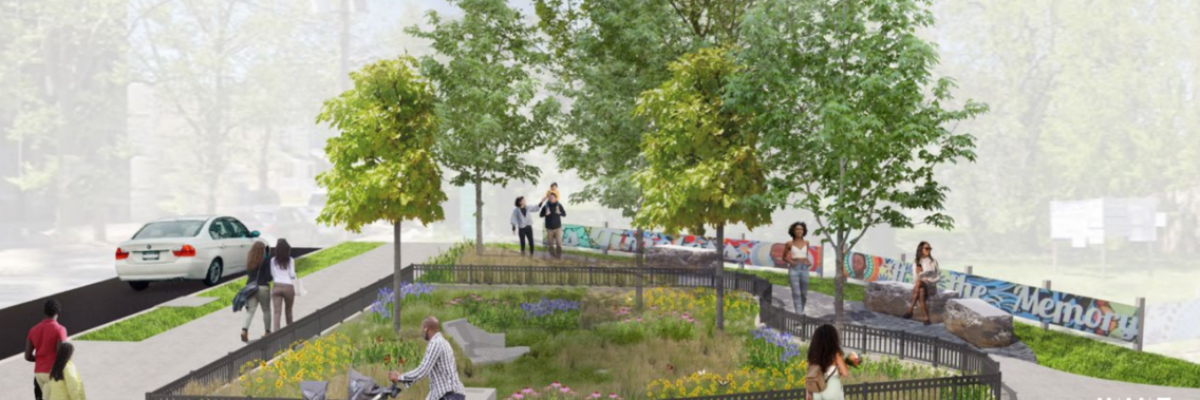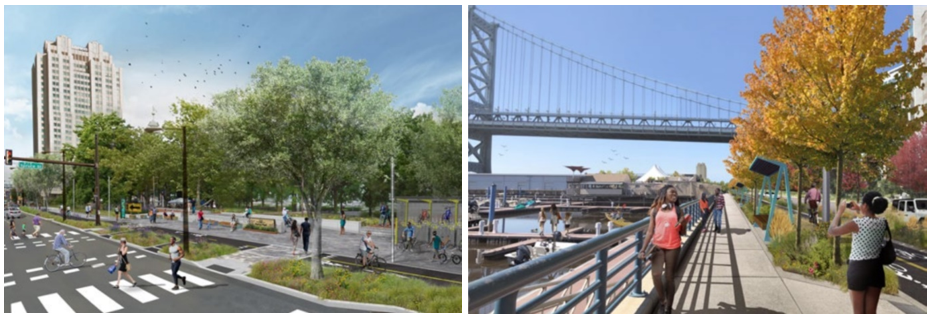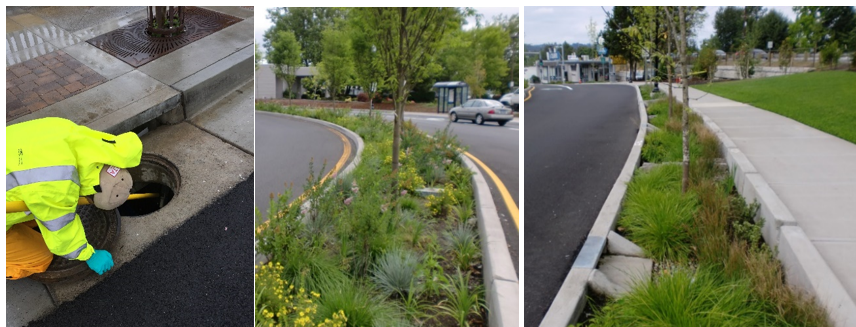Matthew Moore, PE, QSD, ENV SP, Director of Water Resources Engineering
Michael Drennan, PE, Vice President Water Resources and Green Infrastructure
The green infrastructure/green streets/complete streets movement is driven by goals including sustainability, safety, and health. Green infrastructure is a network of natural and semi-natural areas that provide multiple benefits for people and the environment, and when integrated with complete street concepts strengthens the three pillars of sustainability: environment, economy, and social equity. Benefits include:
- Reducing stormwater runoff by capturing and filtering rainwater where it falls, reducing floods and water pollution
- Improving air quality by absorbing pollutants, producing oxygen, and moderating temperatures
- Enhancing biodiversity by creating and connecting habitats for wildlife and plants
- Mitigating climate change by sequestering carbon, reducing greenhouse gas emissions, and increasing resilience to extreme weather events and heat island effect
- Economic benefits including increases in property values and the creation of ‘green’ jobs
- Aesthetic and emotional well-being benefits associated with urban green spaces
Cities throughout the US are at various stages of contemplating or implementing green infrastructure as they are redesigning their urban areas to be more walkable, livable, and enjoyable. Implementing green infrastructure can help communities become more resilient, livable, and sustainable. Below are seven suggested steps to help you achieve a successful green infrastructure project.
Step 1: Assess your current situation and identify your goals. Analyze the existing conditions, challenges, and opportunities for green infrastructure in your area. Define your vision, objectives, and targets for improving environmental, social, and economic outcomes.
- Opportunities can include upcoming Capital Improvement Program projects, updates to drainage, transportation, and landscape/urban forestry planning documents.
- Challenges can include steep terrain, soils that do not drain, high water table, utility conflicts, procedural barriers, and maintenance concerns.
- What are the primary drivers for green infrastructure in your community? Water quality regulations, flooding, groundwater recharge, shade/tree canopy, or resilient/sustainable streets, community aesthetics or redevelopment?
- Program goals may include development of a stand-alone municipal green infrastructure program that includes a funding source, guidelines, standards, specifications, design, and maintenance criteria, and prioritizes green infrastructure implementation locations and projects.
Step 2: Engage stakeholders and build partnerships. Identify and involve the key stakeholders and decision-makers who have a stake or interest in green infrastructure planning and implementation. Include leaders from other disciplines including active transportation, urban forestry, utilities, parks, plaza, and streetscape design to identify opportunities for collaboration with multiple benefits, and to identify constraints such as conflicting agency goals. Also engage with other local community and environmental organizations whose missions may be aligned with green infrastructure directly or indirectly. Communicate the benefits and costs of green infrastructure, address their needs and concerns, and seek their input and feedback. Foster collaboration and coordination among different sectors (public, private, institutional), levels (block, street, neighborhood), and groups.
- Consider developing and/or adopting a green infrastructure guideline document outlining green infrastructure elements, benefits, and implementation strategies for educational purposes.
- Collaborate with maintenance, flood control, transportation, landscape, urban forestry, and development services/plan check staff, as well as the private development community.
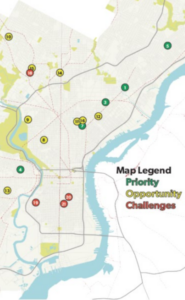
Map and assess the existing green infrastructure assets and gaps in your area. Evaluate their functions, values, and conditions. Identify potential sites and opportunities for enhancing, expanding, or integrating green infrastructure with other infrastructure systems. This may require hiring a consultant with green infrastructure experience.
- Identify potential sites and opportunities that can include multi-layered prioritization including drainage area, flooding potential/history, soils, terrain, adjacent utilities/infrastructure, street trees, right-of-way width, emergency evacuation routes, future infrastructure project locations.
- Begin envisioning how green infrastructure will be implemented within the right of way with other right of way elements and reach out early to coordinate with agencies and/or authorities who hold jurisdiction over the right of way.
- Consider social equity in prioritization of green infrastructure locations.
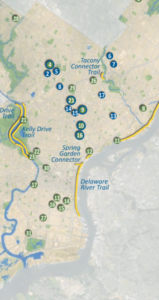
Based on your assessment, stakeholder engagement, and inventory, prioritize the actions and projects that will achieve the most impact and value for green infrastructure in your area. Determine the available funding sources including public and/or private grant and loan programs, design criteria, construction methods, as well as maintenance plans and partners (public or private) for each action or project. Align your strategy and plan with other relevant plans and policies overlapping the same geography.
- Conduct a procedural barrier review to identify conflicting ordinances, policies, and design criteria that may hinder the implementation of green infrastructure within the right of way (for example street tree and sign spacing, site distance, parkway width, road flooding limits.
- Identify potential grant funding sources for individual projects. Green streets may qualify for various sources outside of traditional transportation funding sources, including stormwater, active transportation, and public health related funding sources.
- Determine if agency specific standard plans, specifications, design, and maintenance criteria are desired. Or, if regional standards and criteria are adopted and implemented through local ordinance or policy.
- Integrate green infrastructure provisions into planning documents such as drainage master plans, transportation/complete streets plans, climate action plans, and urban forestry or ‘Green Streets’ plans.
- Develop public engagement and outreach program.
Step 5: Implement green infrastructure projects and programs. Execute your green infrastructure strategy and plan according to the established timeline, budget, and quality standards. Apply best practices and guidelines for green infrastructure installation and operation. Ensure compliance with regulations and permits.
- Assign dedicated resources to managing green infrastructure implementation (development of design and construction standards and specifications, pre-design and design guidance documents, design review, construction inspection, maintenance coordination, tracking, and program funding).
- Consider creating a webpage with green infrastructure project locations and information such as features and benefits projects.
- Continue public engagement and outreach programs.
- Conduct regular program quality assurance reviews and annual reporting (if applicable).
Step 6: Monitor and evaluate green infrastructure performance and impacts. Establish indicators and methods to monitor and evaluate your progress and success. Collect and analyze data on the effectiveness and efficiency of your green infrastructure projects and programs. Measure the outcomes and benefits of green infrastructure for the environment, society, and economy. Communicate and report your results and achievements to stakeholders and the public.
- Consider tracking metrics such as water quality volume treated or infiltrated, area of green infrastructure and number of trees, construction and maintenance costs, ambient air temperature, and water quality monitoring results to better communicate program outcomes and benefits.
- Provide regular updates on program status.
Step 7: Learn from experience, adapt to changing conditions, and celebrate success! Use the information and feedback from monitoring and evaluation to improve your green infrastructure practice. Incorporate new knowledge, innovations, and technologies that can enhance green infrastructure performance or reduce costs. Respond to emerging challenges or opportunities that may affect your goals or actions.
- Assess emerging challenges that may include regulatory changes and further climate change impacts.
- Engage maintenance staff to address any potential design and construction issues that cause maintenance/operation concerns.
- Attend regular seminars on Green Streets, Green Infrastructure, Low Impact Development, and other water quality topics to stay informed on the latest guidance and information on Green Infrastructure implementation.
- Celebrate and share your success to inspire action by others! Present your progress at conferences and publications to spread the word.
We encourage you to let us help you achieve a successful green infrastructure project. Please do not hesitate on reaching out to one of the members on our team:
Matthew Moore, PE, ENV SP: Matthew.Moore@nv5.com
Michael Drennan, PE: Michael.Drennan@nv5.com
Michael Connor, PE: Michael.Connor@nv5.com
Jackson Wandres, RLA, W.E.D.G: Jackson.Wandres@nv5.com
Mike Smyth, RLA, ASLA: Mike.Smyth@NV5.com

